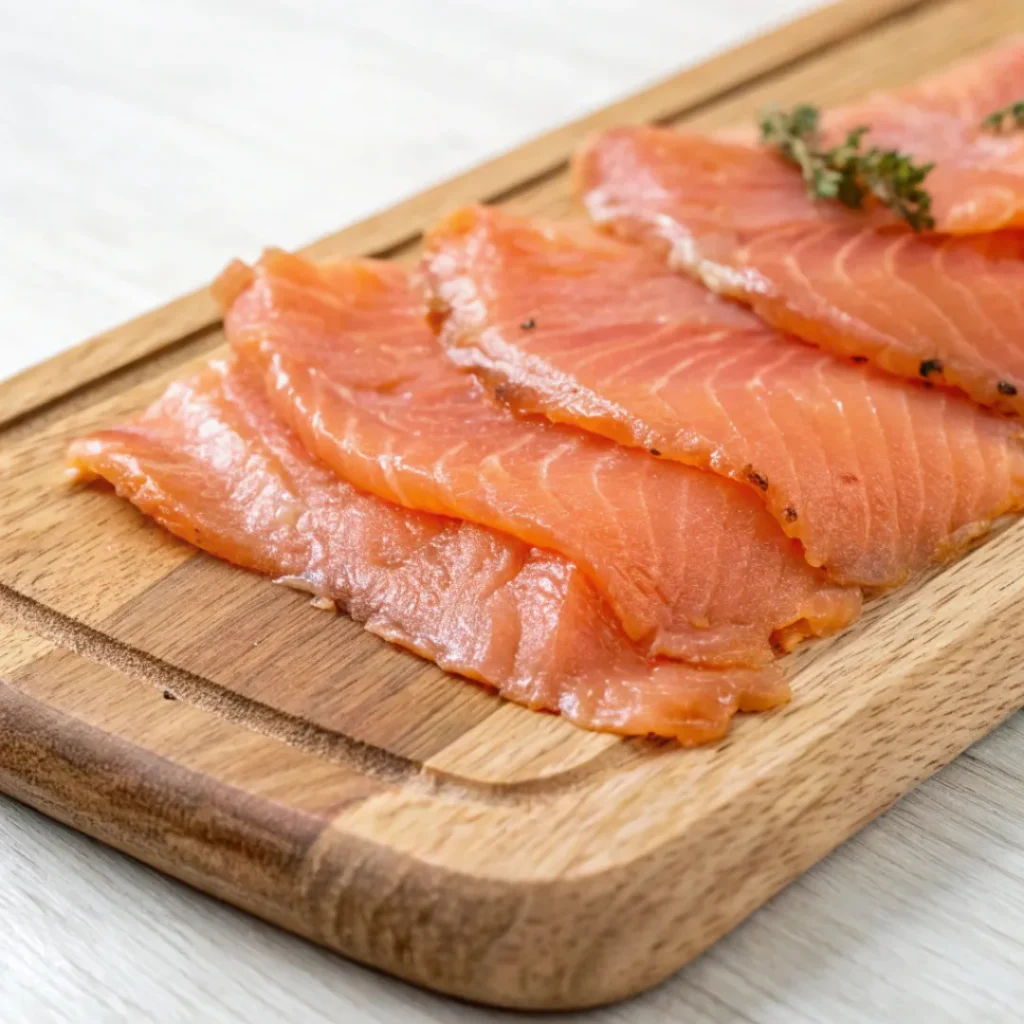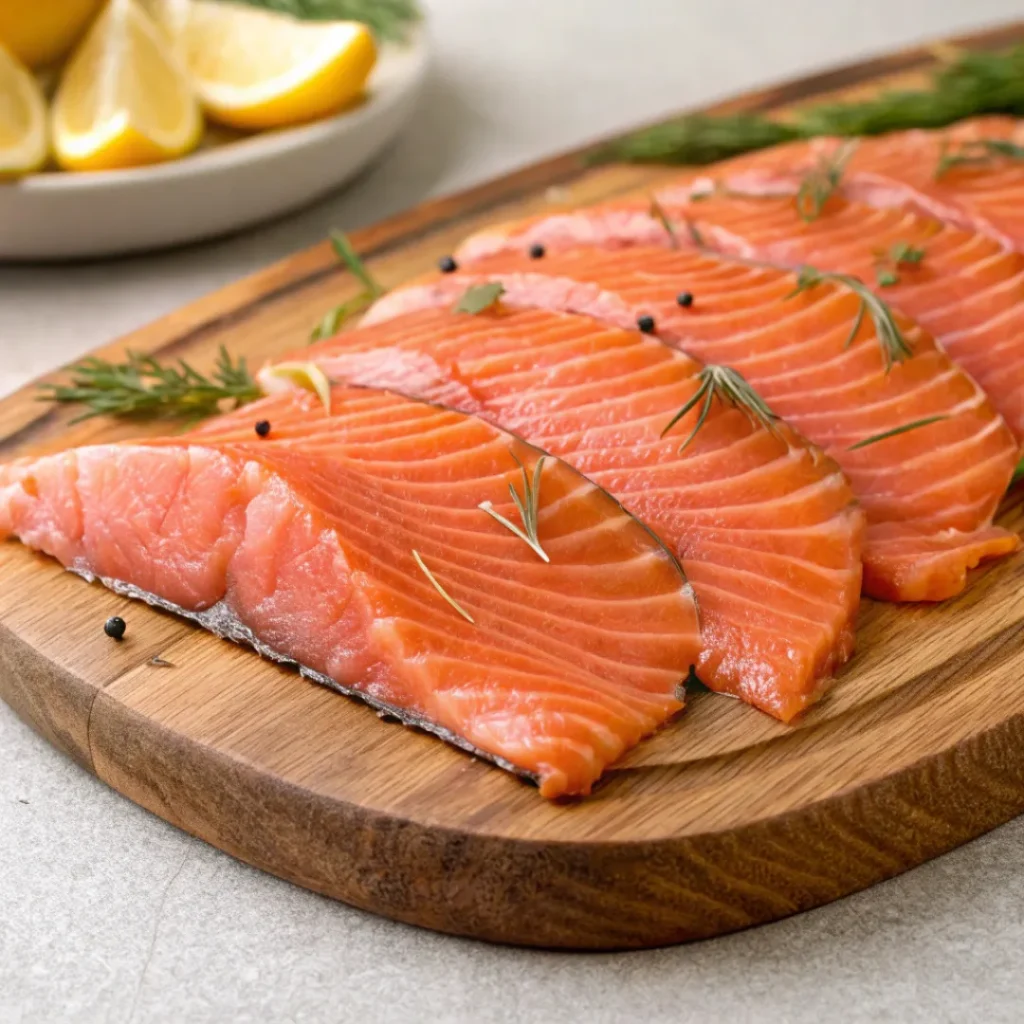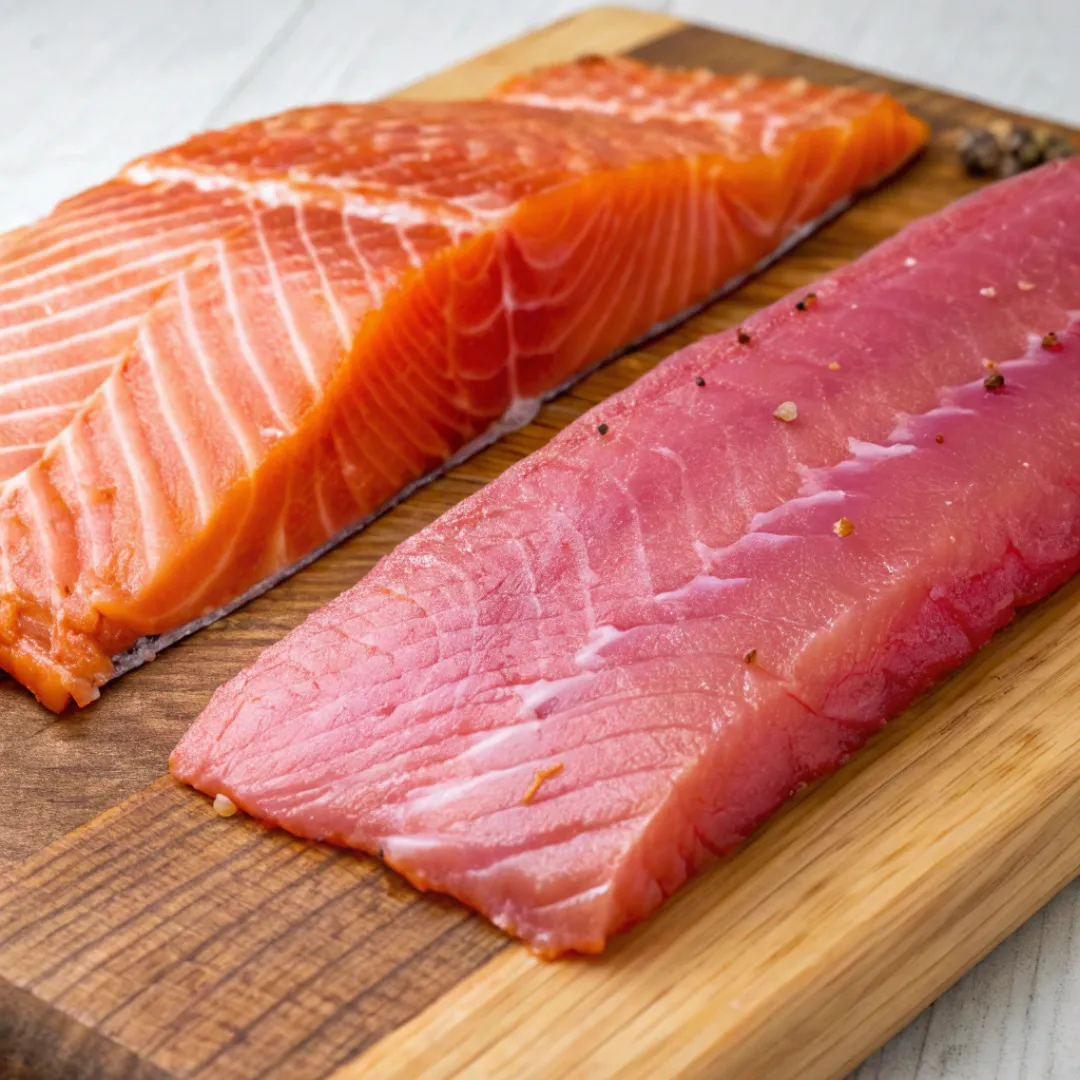People have enjoyed smoked salmon for centuries as both a preservation method and a culinary delicacy. Originating in cultures that needed to preserve fish, the process has evolved into a gourmet tradition cherished worldwide. Whether served atop a bagel with cream cheese or used in sushi, smoked salmon plays a prominent role in both casual and fine dining.
However, many people wonder: Is smoked salmon cooked or raw? The two smoking methods—cold smoking and hot smoking—create confusion around this question. These methods differ in both technique and the texture and flavor they produce. Cold-smoked salmon keeps a raw-like texture, while hot-smoked salmon becomes fully cooked during the process. This distinction shapes how chefs use each type in dishes and determines who can safely enjoy them.
How Smoked Salmon Is Made
Making smoked salmon involves several key steps, including curing, drying, and smoking. Each part of the process contributes to the fish’s flavor, texture, and preservation.
Selection and Preparation
High-quality salmon, such as Atlantic, Sockeye, or Coho salmon, is selected. The fish is cleaned and cut into fillets of uniform thickness to ensure even curing and smoking.
Curing the Fish
Curing is an essential step that removes moisture from the fish, enhancing flavor and ensuring safety. The fish is coated with a mix of salt, sugar, and sometimes herbs or spices. Depending on the recipe, the curing process can take anywhere from 4 to 24 hours.
Drying and Forming the Pellicle
After curing, the salmon is rinsed and allowed to air-dry. This process forms a thin, tacky layer called the pellicle, which helps the smoke cling to the fish, intensifying the flavor during smoking.
Smoking Process
Cold Smoking
The fish is smoked at a low temperature (68-86°F or 20-30°C) for 12 to 24 hours, giving it a raw-like texture.
Hot Smoking
This method cooks the salmon by smoking it at 120-180°F (49-82°C) for 3 to 8 hours, resulting in a firmer, flaky texture.
Cold-Smoked Salmon: Is It Raw or Cooked?
Cold-smoked salmon undergoes a low-temperature smoking process to retain its raw-like texture and delicate flavor. Unlike hot-smoked salmon, it isn’t cooked but cured and smoked at temperatures between 68–86°F (20–30°C), preserving its silky texture.
Explore the difference between Hot-Smoking and Cold-Smoking.

The Smoking Process
Cold-smoked salmon is prepared by exposing the fish to temperatures between 68–86°F (20–30°C). This low temperature ensures the fish never reaches the heat levels required for cooking, allowing it to retain a soft, silky texture. The smoke, combined with a salt-based cure, imparts flavor and preserves the fish without applying direct heat.
Is It Safe to Eat?
Cold-smoked salmon is generally safe to eat when producers properly cure, smoke, and store it. The curing process, which uses salt, removes moisture from the salmon and creates an environment that inhibits bacterial growth. However, health experts advise vulnerable groups—including pregnant individuals, young children, the elderly, and those with weakened immune systems—to avoid raw or minimally processed fish like cold-smoked salmon due to the small risk of Listeria contamination.
How to Enjoy Cold-Smoked Salmon
Though technically raw, cold-smoked salmon is a ready-to-eat delicacy and does not require additional cooking. It is commonly enjoyed in dishes like:
- Bagels with cream cheese, capers, and onions
- Canapés or crostini with herbs and cream spreads
- Salads with dill and lemon dressing
- Sushi or as part of a charcuterie board
Cold-smoked salmon bridges the gap between raw and cured food, offering a delicately smoky, melt-in-the-mouth experience. Its sophisticated flavor makes it a favorite in many kitchens worldwide, from breakfast to elegant appetizers.
Hot-Smoked Salmon: A Fully Cooked Option
Hot-smoked salmon offers a rich, smoky flavor and a firm, flaky texture, making it a favorite Hot-smoked salmon offers a rich, smoky flavor and a firm, flaky texture, making it a favorite among seafood lovers. Unlike cold-smoked salmon, hot-smoked salmon is fully cooked during the smoking process, which enhances its flavor while ensuring it’s safe to eat straight from the package.

The Smoking Process
To prepare hot-smoked salmon, producers smoke and cook it at temperatures ranging from 120–180°F (49–82°C). This process gives the fish a firmer texture, unlike the silky consistency of cold-smoked salmon. Before smoking, they typically cure the fish with salt and sometimes add sugar or spices. This step not only preserves the salmon but also enhances its flavor.
Flavor and Texture
The heat used in hot smoking not only cooks the salmon but also gives it a distinctive smoky taste. The resulting fish is moist and flaky, with a deeper, bolder flavor than cold-smoked salmon. The texture resembles that of baked or grilled salmon, though with a signature smoky twist.
Is Hot-Smoked Salmon Safe to Eat?
Yes, because hot-smoked salmon is fully cooked during the smoking process, it is ready to eat without additional preparation. It does not carry the same risks as raw or cold-smoked salmon, making it a safer option for people in vulnerable groups, such as pregnant individuals, children, and the elderly.
Culinary Uses of Hot-Smoked Salmon
Hot-smoked salmon is incredibly versatile and can be used in a variety of dishes:
Salads
Adds depth to green salads or grain bowls.
Breakfast
Perfect with scrambled eggs or in frittatas.
Pasta
A great addition to creamy sauces or pasta salads.
Appetizers
Works well in dips or served alongside crackers and cheeses.
Main Courses
Can be flaked into rice dishes or served as a main protein.
How to Identify Cooked vs. Raw Smoked Salmon
It can be difficult to tell whether smoked salmon is cooked or raw. Here are some key visual and textural clues to help you identify them.
Visual Clues and Texture Differences
Cold-Smoked Salmon:
- Silky, translucent appearance
- Soft and smooth texture
Hot-Smoked Salmon:
- Opaque and firm
- Flaky texture, similar to grilled fish
Tips for Beginners
Read the Label
Packaging usually specifies whether the salmon is hot or cold-smoked.
Touch Test
Cold-smoked salmon feels soft, while hot-smoked salmon is firmer.
Is Smoked Salmon Safe to Eat?
Both types of smoked salmon are safe to eat when prepared and stored properly. However, there are additional safety concerns with cold-smoked salmon, as it is not fully cooked.
Food Safety Guidelines:
- Refrigerate at 38°F (3°C) or lower.
- Consume Cold-Smoked Salmon within 3-5 days after opening.
- Freeze for Extended Storage: Both types can be frozen for up to 3 months.
Risks for Vulnerable Groups
People with compromised immune systems, such as pregnant women, young children, and the elderly, should opt for hot-smoked salmon, which is fully cooked.
Health Benefits of Smoked Salmon
Smoked salmon is not only a delicious treat but also a nutrient-rich food that offers several health benefits when enjoyed in moderation.
Rich in Omega-3 Fatty Acids
These essential fats support heart health by reducing inflammation, lowering blood pressure, and improving cholesterol levels.
High-Quality Protein
Smoked salmon provides complete protein, essential for muscle growth and tissue repair.
Vitamins and Minerals
It is a good source of B vitamins (such as B12 and B6), which support brain function and energy metabolism. Additionally, it contains vitamin D, which aids calcium absorption and promotes bone health.
Antioxidants
Smoked salmon contains astaxanthin, a powerful antioxidant that supports eye health and reduces oxidative stress.
Brain Health
Regular consumption of omega-3s from fish like smoked salmon is linked to improved cognitive function and a lower risk of neurodegenerative diseases.
Potential Risks of Eating Smoked Salmon
While smoked salmon offers health benefits, it also comes with certain risks.
Sodium Content and Moderation
Smoked salmon is high in sodium, which can contribute to high blood pressure if consumed in excess.
Mercury Levels and Allergic Reactions
Like other seafood, salmon may contain trace amounts of mercury. Some individuals may also be allergic to salmon.
How to Enjoy Smoked Salmon
Smoked salmon’s versatility makes it a favorite in a wide range of dishes, from breakfast spreads to elegant appetizers. Here are some popular ways to enjoy it:

Breakfast Ideas:
- Bagels with cream cheese, capers, red onions, and smoked salmon slices.
- Scrambled eggs topped with smoked salmon and herbs like chives or dill.
- Smoked salmon on toast with avocado and lemon drizzle.
Appetizers and Snacks:
- Smoked salmon canapés with cream cheese, cucumber, and fresh dill.
- Crostini topped with smoked salmon, goat cheese, and arugula.
- Rolled into wraps with soft cheese, spinach, and pickled vegetables.
Salads and Mains:
- Add to mixed greens with avocado, red onion, and a lemon vinaigrette.
- Toss with pasta or risotto for a smoky twist.
- Serve flaked hot-smoked salmon over rice bowls or grain salads.
Sushi and Charcuterie Boards:
- Use cold-smoked salmon for sushi rolls, sashimi, or poke bowls.
- Incorporate into seafood-themed charcuterie boards with cheeses, olives, and crackers.
Storage Tips: Keeping Smoked Salmon Fresh
Proper storage is essential for maintaining freshness and safety.
- Refrigerate unopened packages for up to 2 weeks.
- After Opening: Consume within 3-5 days.
- Freeze smoked salmon for up to 3 months.
Frequently Asked Questions
Can I smoke salmon without curing it?
No, curing is essential to remove moisture, enhance flavor, and prevent bacterial growth during the smoking process.
How long does smoked salmon last?
- Refrigerated: 3-5 days after opening.
- Frozen: Up to 3 months if stored properly.
Which type of smoked salmon takes longer—hot or cold?
Cold-smoked salmon takes longer, requiring up to 24 hours. Hot-smoked salmon is quicker, typically done in 3 to 8 hours.
Do I need special equipment to smoke salmon?
A smoker is recommended, but you can also use a grill with indirect heat and wood chips.
Can I reheat hot-smoked salmon?
Yes, hot-smoked salmon can be reheated or added to hot dishes like pasta and eggs.
Conclusion
The smoking method determines whether smoked salmon is considered cooked or raw. Cold-smoked salmon keeps a texture similar to raw fish, while hot-smoked salmon undergoes full cooking. Both types deliver unique flavors and offer various health benefits, making smoked salmon a versatile ingredient across many cuisines.
You can enjoy it on a bagel, in sushi, or as part of a meal. Smoked salmon consistently adds a delightful touch to your diet, whether used in breakfast dishes, appetizers, or main courses.

